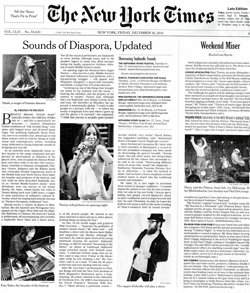 If you missed it, the NY Times article on the 7th Sephardic Music Festival hit newsstands Friday, click here to check the article online.
If you missed it, the NY Times article on the 7th Sephardic Music Festival hit newsstands Friday, click here to check the article online.
FULL ARTICLE BELOW:
Sounds of Diaspora, Updated
By AMANDA PETRUSICH
Published: December 15, 2011
BROADLY defined, “Jewish music” typically evokes the wild fury of klezmer or — and this is particularly unfortunate — tuneless elementary school renditions of “The Dreidel Song,” complete with fudged lyrics and ill-timed handclaps. The weeklong Sephardic Music Festival, now in its seventh year, should put to rest those notions with its eclectic lineup of traditional and contemporary artists, including many dedicated to fusing disparate sounds or bridging new and old.
As an umbrella term, Sephardic music refers loosely to the songs composed and performed by descendents or followers of Sephardi Jews, who occupied the Iberian Peninsula until their exile in the late 15th century; many resettled in Ottoman strongholds (Turkey, Greece, Bulgaria and the Balkan lands that eventually formed Yugoslavia), parts of the Middle East and North Africa. Erez Safar, the founder and producer of the festival, said that while he often described Sephardic music as “Jewish Middle-Eastern music,” most definitions were too narrow or too broad. Mostly, Mr. Safar, whose family has roots in Yemen dating back over 2,000 years, is eager to raise awareness of Judaism’s cultural diversity, which he emphasized extends beyond its “Eastern European, Ashkenazi” face.
Spread across a variety of places in Manhattan, like theSpanish and Portuguese Synagogue on the Upper West Side and the Highline Ballroom in Chelsea, the festival’s lineup is deliberately all-encompassing and includes a Sephardic Story Slam and a dance party. Not all the musical performers are Sephardic or even Jewish, although many nod to the peoples’ legacy in some way, often incorporating the heady, propulsive rhythms inherent in much Middle Eastern music.
On opening night the Mexican-born singer Nuriya — who marries Latin, Middle Eastern and classical influences and performs with a hip-quivering swagger — will appear with Pharaoh’s Daughter, a psych-folk ensemble, and Haale, a songwriter of Iranian descent.
“Growing up, one of the things that brought me closer to my Judaism was the music — hearing the melodies and the prayers of the cantors in temple,” Nuriya said. Although she’s not Sephardic (her family is from Syria and Iraq; she identifies as Mizrahi), her approach is intentionally global. “I want to take people on a journey with me — to where my family is originally from and where I grew up and the places I’ve traveled,” she explained. “I think that journey is actually quite symbolic of the Jewish people. We started in one place and had to move and go to other places, picking things up along the way.”
On Dec. 24 the Israeli singer and guitarist Miki Gavrielov — “basically the godfather of modern Israeli music,” Mr. Safar said — will headline a show with the Boston-born fiddler and songwriter Lily Henley. Although Mr. Gavrielov, 62, said he spent much of his young adulthood denying his parents’ Sephardic heritage, in 1991 he released “Dreaming of My Home,” an album of traditional Sephardic songs recorded mostly with Turkish musicians. “I collected Turkish songs that my father used to sing every Friday at the dinner table while he was drinking a bit,” Mr. Gavrielov said in an e-mail. “It took me 40 years to feel free and start dealing with my roots.”
After Mr. Gavrielov’s performance Le Poisson Rouge will hold the New York iteration of Heeb Magazine’s Heebonism party, a longstanding, oft-rowdy rebuttal to the solemnity of Christmas Eve. (In 2009 it was featured on the Travel Channel’s “Extreme Wild Parties.”) “Heeb attracts a particular crowd — secular, Jewish, very urban,” David Kelsey, the magazine’s publisher, said. “Heebonism draws a broader crowd. People get curious.”
Since the festival’s inception Mr. Safar, who is chief executive of Shemspeed, a record label and promotion company, has been intent on showcasing the genre’s breadth. “Jewish music, like any other music, has always been influenced by the culture that surrounds it,” he said in an e-mail. “Showcasing different styles of music that ‘sound’ like Sephardic — Bukharian, Yemenite, Tunisian, Persian, Syrian or otherwise — is what the festival is about. And we have a heavy emphasis on how modern music is mixed into the traditional sounds and melodies.”
Mr. Safar, 32, is also eager to introduce these artists to younger audiences. “I wanted Sephardic culture to not only be seen as beautiful, but also as hip and fresh. I always got a feeling that people viewed Sephardic music as more traditional and less experimental and fun,” he said. Ultimately, he said, he hopes his festival will cause a shift in the understanding of “what it means to ‘look’ or ‘sound’ Jewish.”
THE SEPHARDIC MUSIC FESTIVAL Tuesday to Dec. 27, Information on times, locations and tickets: sephardicmusicfestival.com.
Events mentioned in the article:
NURIYA, PHARAOH’S DAUGHTER AND HAALE Tuesday, 7 p.m., Le Poisson Rouge, 158 Bleecker Street, between Thompson and Sullivan Streets, West Village;lepoissonrouge.com, nuriyamusic.com, pharaohsdaughter.com, haale.com; $18.
MIKI GAVRIELOV, THE ISRAMERICA HOUSE BAND AND LILY HENLEYDec. 24, 6:30 p.m., Le Poisson Rouge; lepoissonrouge.com, mikigavrielov.com/english,lilyhenley.com; $25 to 60.
HEEBONISM Dec. 24, 10:30 p.m., Le Poisson Rouge; lepoissonrouge.com,heebmagazine.com; $15 in advance, $20 at the door.
SEPHARDIC STORY SLAM Dec. 27, 7 p.m., Triad Theater, 158 West 72nd Street, second floor, Manhattan; triadnyc.com; $12.
full article at http://www.nytimes.com/2011/12/16/arts/music/sephardic-music-festival-in-new-york.html?_r=4